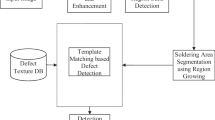Abstract
Automatic inspection and classification of printed circuit board (PCB) defects remains a problem in the Integrated Circuit (IC) industry. In a small volume, large production variety environment, some of the widely used defects classification tools are the Bayes classifier, the linear discriminant function (LDF) classifier, the minimum distance classifier, and the K-nearest neighbour (K-NN) classifier. These classifiers all have shortcomings and their applications are limited. This study proposes the logistic regression tree as classifier where each node implements a logistic regression model to make a binary split, and draws a comparison with other classifiers. This experiment uses the Red-Green-Blue (RGB) values of an image with PCB golden fingers, as opposed to some features extracted from the image. The golden fingers defects considered in this study are scuffing, blotted tin, exposed nickel, and unplating. The result of this experiment shows that the logistic regression tree has an accuracy of 89.33%, while other classifiers can only achieve 81.67% to 87.17%. Furthermore, the decision flexibility and the result stability show that the logistic regression tree is an excellent choice as a classifier.
Similar content being viewed by others
References
Chan J, Braggins D (1996) Untiring eyes. Manuf Eng 75(5):233–235
Chou PB, Rao AR, Sturzenbecker MC, Wu FY, Becher VH (1997) Automatic defect classification for semiconductor manufacturing. Mach Vision Appl 9(4):201–214
Newman TS, Jain AK (1995) A survey of automated visual inspection. Comput Vision Image Underst 61(2):231–262
Moganti M, Ercal F (1995) Automatic PCB inspection systems. IEEE Potentials 14(3):6–10
Wu W, Wang MJ, Liu C (1996) Automated inspection of printed boards through machine vision. Comput Ind 3:103–111
Scarlett JA (1999) An introduction to printed circuit board technology. Electrochemical Publications, England
Tasi DM, Tasi YH (2002) Rotation-invariant pattern matching with color ring-projection. Pattern Recogn 35:131–141
Tasi DM, Tseng CF (1999) Surface roughness classification for castings. Pattern Recogn 32:389–405
Jiang BC, Lin TT, Wang CC (1999) A study of using machine vision system for surface defects classification. J Chin Inst Ind Eng 16(4):443–453, in Chinese
Jiang BC, Wang YM, Wang CC (2001) Bootstrap sampling techniques applied to PCB golden fingers defect classification study. Int J Prod Res 39(10):2215–2230
Wang CC, Jiang BC (2001) PCB solder joints defects detection and classification using machine vision. Int J Ind Eng 8(4):359–369
Chao K, Chen YR, Early H, Park B (1999) Color image classification systems for poultry viscera inspection. Appl Eng Agric 15(4):363–369
Hata S, Miyashita SY, Hanafusa H (1996) Human sensitivity of color defects inspection. Proceedings of The 1996 IEEE IECON 22nd International Conference on Industrial Electronics Control and Instrumentation, Takamatsu, Japan, pp 713–719
Barth M, Hirayama D, Beni F, Hackwood S (1992) A color vision inspection system for integrated circuit manufacturing. IEEE Trans Semicond Manuf 5(4):290–301
Capson DW, Eng SK (1988) A tired-color illumination approach for machine inspection of solder joints. IEEE Trans Pattern Anal Mach Intell 10:387–393
Ripley BD (1996) Pattern recognition and neural networks. Cambridge University Press, New York
Wang CC, Jiang BC (1998) The application of machine vision inspection using bayes method. Proceedings of the 4th National Quality Management Symposium, Taiwan, pp 404–414, in Chinese
Breiman L, Friedman JH, Olshen RA, Stone CJ (1984) Classification and regression tree. Wadsworth, California
Collica RS (1993) A logistic regression yield model for SRAM bit fail patterns defect and fault tolerance in VLSI system. The IEEE International Workshop, USA, pp 127–135
Chen PL (1999) Logistic regression trees application for PCB defects classification. Master Thesis, Yuan Ze University, Taiwan
Wang CC, Jiang BC (1998) Application of logistic regression method for semiconductor process analysis. J Qual 5:91–105, in Chinese
Hosmer DW Jr, Lemeshow S (2000) Applied logistic regression, 2nd edn. Wiley, New York
Ostu N (1978) A threshold selection method from grey-level histogram. IEEE Trans Syst Man Cybernet 8:62–66
Author information
Authors and Affiliations
Corresponding author
Rights and permissions
About this article
Cite this article
Jiang, B., Wang, C. & Chen, P. Logistic regression tree applied to classify PCB golden finger defects. AMT 24, 496–502 (2004). https://doi.org/10.1007/s00170-002-1500-2
Received:
Accepted:
Published:
Issue Date:
DOI: https://doi.org/10.1007/s00170-002-1500-2




